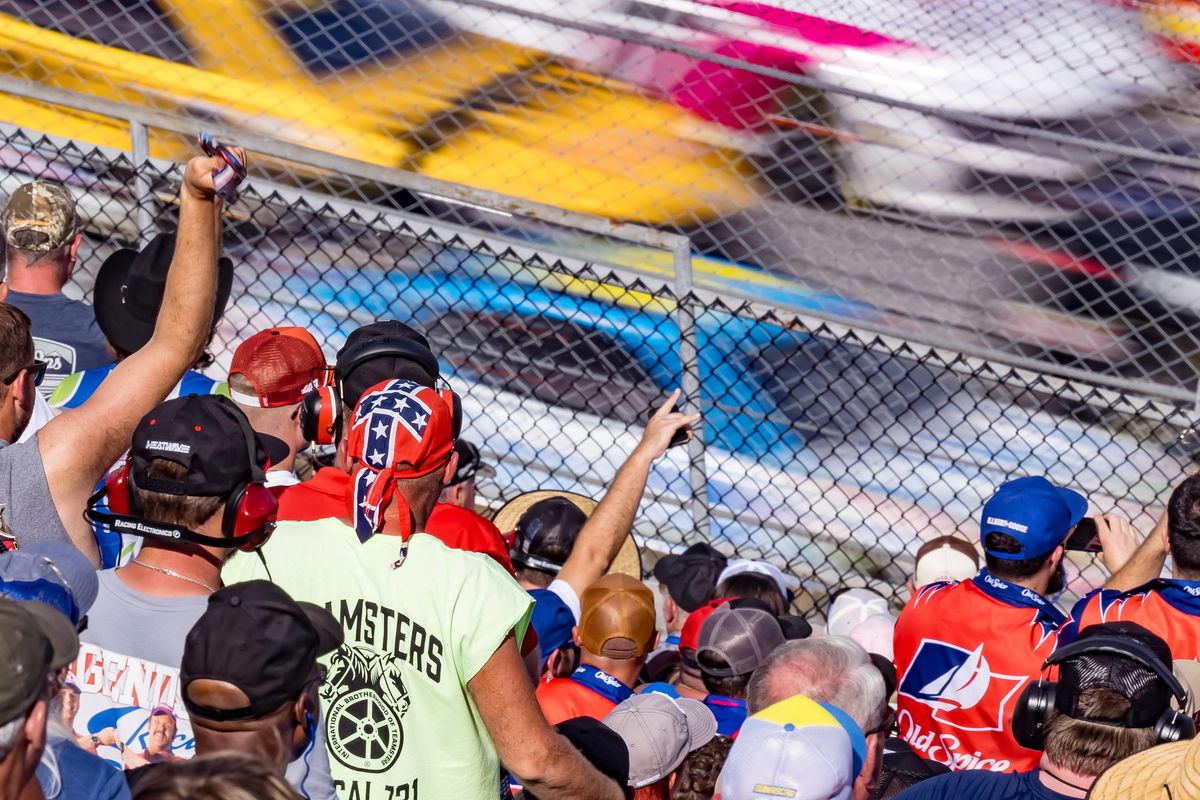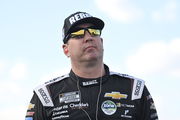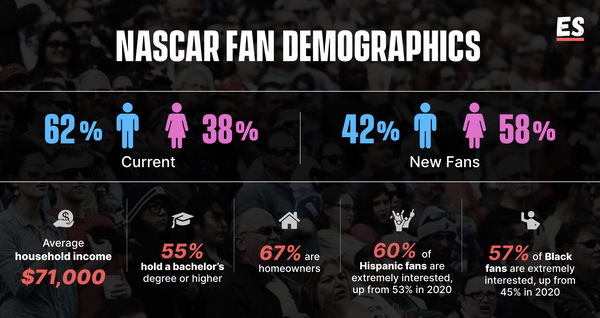
Imago
October 6, 2024, Lincoln, Al, USA: Fans watch their favorite drivers race at Talladega Superspeedway, in the YellaWood Pressure Treated Pine 500. An exhilarating event showcasing high-speed action and skill in the heart of Lincoln, AL. Lincoln USA – ZUMAa161 20241006_aaa_a161_007 Copyright: xWalterxG.xArcexSr.x

Imago
October 6, 2024, Lincoln, Al, USA: Fans watch their favorite drivers race at Talladega Superspeedway, in the YellaWood Pressure Treated Pine 500. An exhilarating event showcasing high-speed action and skill in the heart of Lincoln, AL. Lincoln USA – ZUMAa161 20241006_aaa_a161_007 Copyright: xWalterxG.xArcexSr.x
We’ve seen it before. Back in the good ol’ days, diehard NASCAR fans were in the grandstands, decked out in their favorite driver’s apparel and waving their flags passionately on the sidelines. But times are changing, and in the digital world, ‘modern fans’ are coming from social media, sim-racing leagues, and micro-betting apps. Drivers are changing, too, with Dale Jr. and Denny Hamlin’s podcasts proving to be a gateway for the next generation of stock car racing enthusiasts, many of whom couldn’t care less about horsepower or the sport’s Southern roots.
Watch What’s Trending Now!
Social Media and the Rise of Personality-Driven Fandom
If social media is anything to go by, it’s the clearest indicator of NASCAR’s changing audience. Recently, YouTuber IShowSpeed pulled up at Daytona International Speedway on his livestream to collaborate with Carson Hocevar, which just goes to show that racers are not just expected to perform on the track, but play the role of influencers off it.
ADVERTISEMENT
Denny Hamlin’s Actions Detrimental podcast gives behind-the-scenes insight and offers an unfiltered look at the sport, while Bubba Wallace livestreams on Twitch. Meanwhile, Ross Chastain’s viral moments, like the ‘Hail Melon,’ are enjoyed by non-NASCAR fans as well. Social media, particularly TikTok and Instagram, has given new life to the sport, even reaching people who wouldn’t normally sit through an entire race.
It also penetrates through an audience that is significantly younger than the majority demographic. Drivers feel more accessible, and fans can follow their day-to-day lives instead of waiting for racedays. For the racers, getting a fan following on social media opens them up to sponsorship opportunities, which play a significant role in getting funding in a hugely competitive sport. In the long term, this type of social media consumption will build loyalty, just like fans in the old days felt for drivers and manufacturers.
Top Stories
‘NASCAR on Sale’: Team Owners Interested to Buy Out France Family With $5B Price Tag

Kyle Busch Hits Rock Bottom as Snowball Derby Nightmare Sparks Wave of Fan Sympathy

NASCAR Driver Left Helpless for 2026 as Chevy Drops the Axe on Daytona Winning Star

Kyle Larson Reveals Rick Hendrick’s Pet Peeve While Roasting His On-Track Blunders

Snowball Derby Rocked by Conspiracy Theories as NASCAR Driver Forced to Abandon Race

ADVERTISEMENT
Gaming and Esports as a Gateway
Another avenue for NASCAR to get new fans is gaming and esports. Gone are the days when iRacing was a professional simulator designed only for racing drivers. The company is developing NASCAR 25, the first standalone console title for the PlayStation 5 and Xbox Series X. Releasing on October 14th, 2025, the game could be a gateway for non-stock car racing enthusiasts and serve as an entry point to the sport.
The sanctioning body has also relied on the eNASCAR Coca-Cola iRacing Series, a competitive league that now features 40 drivers, to popularize the sport. There’s a significant prize money up for grabs, and the event is streamed live, with Parker White winning the 2024 title in a dramatic season finale at Homestead-Miami Speedway. There are also amateur iRacing competitions and youth initiatives like the NASCAR Ignite Series, specifically designed for teenagers to learn the ropes of competitive virtual racing.
ADVERTISEMENT
Three elite drivers. One incredible game.
Hit the track as your favorite stars when the green flag flies on @NASCAR25Game, coming October 14! pic.twitter.com/8fVMpTICu9
— NASCAR (@NASCAR) August 23, 2025
Such programs allow the younger generation to connect with NASCAR. The newer fans don’t want to just passively watch races from their couches; they want to compete on the same tracks as their heroes and learn the intricacies of the sport like tire management, drafting, and the layout of popular venues. Such experiences don’t need to motivate younger fans to attend races in person, but it does create an alternate path to the stock car racing world.
ADVERTISEMENT
Betting and the Business of Engagement
It’s not only esports and video games that are motivating fans to engage in the NASCAR world. Legalized sports betting has changed the game, where motorsports enthusiasts don’t just root for their favorite driver on the sidelines, but have some skin in the game by placing micro-bets during races. The sanctioning body partnered with nVenue in 2023, which enabled real-time sports betting and let fans put their money on stage winners, fastest laps, and the podium finishers.
Earlier this year, NASCAR went one step further by integrating betting probabilities directly into broadcasts thanks to a collaboration with Warner Bros. Discovery. This turned a simple race coverage into a more interactive experience, as fans could see the odds change as the race went on. In states where betting is legal, the sanctioning body is already seeing clear spikes in engagement.
However, there is a downside to it, too. According to some critics, gambling could cheapen NASCAR’s image and shift the attention from the tradition of iconic events like the Daytona 500 or Coca-Cola 600 into something transactional. Ultimately, the sanctioning body needs to find a balance where betting encourages interactivity but not at the expense of racing prestige.
ADVERTISEMENT
The Traditional Fan vs. the New Fan
NASCAR is seeing a major shift in the sport. For decades, the fandom was defined by showing support for a driver or manufacturer that went back generations. There was also a trackside culture, with families driving up to the venue in their RVs, and the entire weekend was planned around attending races. Tailgating and soaking in the atmosphere at iconic venues such as Daytona, Darlington, and Charlotte Motor Speedway.
In comparison, the new fan starts off very differently. They don’t necessarily have Southern roots or strong ties to a manufacturer or a family tradition of attending races. Instead, their connection is built by following drivers on Instagram, racing virtually, or betting on the outcome of the racetrack. The new fandom isn’t directly connected to the history of the sport of a particular manufacturer. All they care about is the face of the driver that pops up on their mobile.
ADVERTISEMENT
The good news is that the heroes and personalities of the sport are still crowd pullers, but NASCAR needs to find a remedy to provide a true sporting experience.

ADVERTISEMENT
Challenges and Risks
NASCAR has always been unapologetically a Southern sport, embracing its quirks without a second thought over the years. But with the digital era here, there are some inherent risks involved now that the sanctioning body is pivoting from its strategy. Audiences on social media have a poor attention span, and viral videos don’t necessarily translate to ticket sales or increased viewership.
ADVERTISEMENT
The sport is also implementing more road course races into the calendar to expand its market, while the inclusion of Amazon Prime Video as a streaming partner didn’t go down well with older fans. Integrating betting and social media influencers means there is a risk that the essence of the sport is lost, reducing the races to a ‘product’ rather than an experience. And if long-term supporters feel that the sport has moved too far away from its roots, NASCAR could risk losing the very foundation it has been built on.
Conclusion
NASCAR finds itself in a tricky situation. On one hand, the sanctioning body needs to adapt and embrace the digital era, even if the ‘new fan’ will never buy a ticket for the Daytona 500 or Coca-Cola 600. But on the other hand, the sport can’t lose the infield tailgaters and multigenerational families that have supported the sport for decades. What is clear is that the future of NASCAR’s fandom doesn’t lie in the grandstands, but on social media, esports tournaments, and betting apps. The question is, how much will it influence the sanctioning body’s strategy in the long run?
ADVERTISEMENT
ADVERTISEMENT
ADVERTISEMENT

